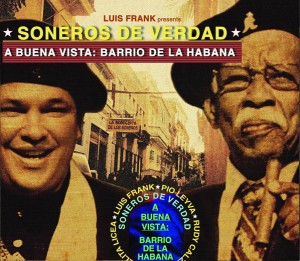 The danzón “El Club Social de Buena Vista” was written about the Buena Vista district of Havana by the great Cuban musician Israel López and subsequently provided the name for the recordings of the now globally known “Buena Vista Social Club“.
The danzón “El Club Social de Buena Vista” was written about the Buena Vista district of Havana by the great Cuban musician Israel López and subsequently provided the name for the recordings of the now globally known “Buena Vista Social Club“.
This project has succeeded in restoring Cuban son music to the level of populańty it once enjoyed in Europe, the United States, and around the world in the 1930s, 40s and 50s.
The great Cuban musician Arsenio Rodríguez, the “blind marvel”, also wrote his tune “Buena Vista en Guaguancó” about this Havana borough, which like many olther parts of the city has a rich musical Tradition.
The piece “Papy Oviedo y Sus Soneros” by Lázaro Blanco, performed by Papi Oviedo(a son of the great Isaac oviedo),also refers to the barrio of Buena Vista and the soneros who play their music there,and in “los barrios de la Habana”, recorded by José Luis Cortéz´s ‘NG la Banda, Buena Vista is described as a neighborhood with plenty of pista, meaning a happening place where one can enioy the pleasures of life.
In order to pay homage to the neighborhood of Buena Vista and the work of the great Cuban tres player Juan de Marcos González, Luis Frank invited a group of uniquely talented musicians of various generations to gather at Abdala Studios in the Miramar district of Havana. One of the songs featured on this CD, ”A Buena Vista” written by Luis Frank, continues the tradition of singing about this barrio, which is home to the rumba, son and guaguancó. And the studio witnessed a whole parade of excellent musicians, of veteran soneros and talented young upstarts, staging a musical feast of a caliber rarely experienced. And, in fact, the whole purpose of this CD is to perpetuate this tradition, with the old guys singing and playing next to youngsters, all members of the same big family of soneros. A long line of accomplished musicians contributed to creating this spicy, authentically flavored mix: the old masters of Cuban music Pío Leiva, Manual ”Puntillita” Licea and Rudy Calzado, who has been living in New York for more than 40 years; the brilliant tres player José ”Maracaibo” Castañeda, who has enormously enhanced the reputation of Cuban music; Juan de Marcos González, the man whose project set in motion the global renaissance of Cuban son music, featured on this CD singing Manuel Corona’s ”Longina” in duet form together with Luis Frank; the outstanding pianist Guillermo ”Rubalcaba” González and his son Jesús, who were invited to play on ”La Más Bella Canción” written by Rudy; the voice of Luis Frank, that great sonero who is continuing the tradition of Benny Moré, Roberto Faz and Miguelito Cuní; excellent musicians of his group ”Tradicional Habana” under the competent musical directorship of Manuel de la Cruz, who also wrote ”Hoy la Lluvia” and ”Glondrina Guajira”; Ricardo Martínez and Patricio Matienzo on percussion, both of them experienced musicians who also played with ”Los Bocucos”, the group in which Ibrahim Ferrer sang; the young and talented bass players Ricardo Muñoz of the ”Afro Cuban All Stars”, Ricardo Quevedo of ”Tradicional Habana”, and Pedro Pablo Gútierrez (formerly of ”Charanga Habanera” and ”Charanga Forever”); the young tres player Manuel Hernández, who has already gathered extensive experience playing with the most important groups devoted to rural Cuban music; master trumpeter Daniel ”El Gordo” Ramos, who gives a brilliant exhibition of good Cuban music; and the youngest of all, Yulién Oviedo Sánchez playing Cuban percussion rhythms like a real pro side by side with veteran masters old enough to be his grandparents; and last but not least, the excellent flute player ”Polo” Tamayo, who spent many years playing with ”Ritmo Oriental” and is now with the ”Afro Cuban All Stars”.
During an eventful five days, we succeeded in capturing the history of Cuban son — from its origins in the small bunga bands of eastern Cuba, its evolution with the trio ”Matamoros”, the ”Sexteto Habanero” and the septet of Ignacio Piñeiro, the great voices of Abelardo Barroso and CArlos Embale, the arrival of son in New York with Don Azpiazu, Mario Bauzá and Machito in the 1940s, and in Paris with Julio Cueva, Moisés Simons and Eliseo Grenet, with Don Azpiazu and his orchestra, and with Antonio Machín. We recorded the sounds of the big bands of the 1940s and 50s, those of the groups ”Arcaño y Sus Maravillas”, of Arsenio Rodríguez, the trumpet of Félix Chapottín, and from the 1950s Benny Moré, Roberto Faz, Nelo Sosa, the ”Conjunto Casino”, and many others as well … and then we returned to Havana of the 1990s with ”NG la Banda”, ”Habana Casino”, Luis Frank and his ”Tradicional Habana”, ”Charanga Habanera”, ”Bakuleyé”, Cotó and his ”Eco Del Caribe”, the ”Afro Cuban All Stars”, ”Sierra Maestra”, ”Papi Oviedo y Sus Soneros”, ”Los Van Van” … and innumerable others.
These recordings embody both the past and the present. They stand for musical continuity, an opening up to the world, reconciliation among Cubans, the fusion of old and new, the blazing of new trails, and an acknowledgement of the greatness of Cuban son music. They emerged from five glorious days spent together by a great family of soneros. And it is our fervent hope that they will contribute to keeping this tradition alive: Buena Vista, Barrio de la Habana!
Juan Carlos Alonso